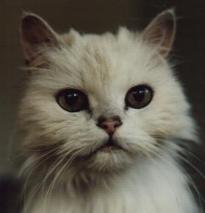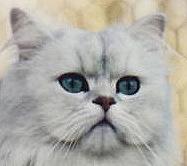
Old-Style Chinchilla

Modern Chinchilla
THE HISTORY OF SILVER LONGHAIRS 2 - STERLINGS, TRADITIONAL LONGHAIR SILVER AND GOLDEN, SHADED AND TIPPED
The early Silvers had the essential characteristics of the modern equivalents, but were very different in conformation and quality of markings from today's show-quality silvers. Some silvers were probably genetically blue, while others were "spoiled silver tabbies" with barred legs, ringed tails and dark blotches on their coats. All Chinchilla lines ultimately trace to a female called Chinnie (b. 1882). The colour of her parents has not been recorded for posterity and there appear to be no surviving photographs of Chinnie herself. In those days, cats of unknown parentage simply meant they lacked pedigree papers and the term "pure-bred" was sufficient in dealings between breeders.
The origin of the Chinchilla Persian breed was a female cat called Chinnie, born in 1882. She was probably either a Silver Mackerel Tabby or a Spotted Tabby Longhair whose pattern was diffused by her long hair and her weak markings would be considered heavy by modern standards. Her exact ancestry is unknown though it included prize winning grandparents on one side and a stray tomcat on the other. She was unusual enough for interested parties to want to breed similar cats from her so she was mated to Fluffy I, a prize-winner of unknown parentage, who was a very pure Silver with "undecided tabby markings." One of their descendants, Beauty, was mated to a Smoke and produced the first recognisable Chinchilla, Champion Silver Lambkin. The Chinchilla was recognised for exhibition in its own class in 1894. Early Chinchillas had a range of levels of tipping and some confusion as to how much tipping was ideal. Orange eyes were preferred and in 1895, "Fur and Feather" carried an article regarding a green-eyed Chinchilla, "It is useless to think of exhibiting her on account of her green eyes," but green eyes later became a defining feature of Chinchillas.
In 1900 the Silvers class was split into Silver Tabbies, Chinchillas or "Self Silvers" (light tipping) and Shaded Silver (heavy tipping). There were cats which fell somewhere between the ideal tipped and ideal shaded, plus different judges had different ideas as to where the line should be drawn. The same cat might be rejected from both classes due to different judges' opinions, or it might be entered into both classes and won both! The Chinchilla and Shaded Silver classes were then combined to prevent confusion. Red and cream Chinchillas had appeared in the USA in 1934 through breeding Silver Chinchillas to Red Self Persians.
The modern squashed-face Persian looks very different from its ancestors due to breeding “typier” cats after World War II. By the 1990s, breeders were becoming concerned that Chinchilla cats were following the ultra-type route taken by other Persians. Traditionally, the Chinchilla had retained the longer muzzle. In America this temporarily resulted in a new breed classification, the Sterling, for the traditional-type Chinchillas. Older-style Chinchillas remain more popular with members of the public, but the showbench Chinchilla has moved inexorably towards the squashed-in look of other Persians. Outcrossing to other, already ultra-typed, Persian varieties is losing the old Chinchilla look. The photos below show cats of both types.
 Old-Style Chinchilla |
 Modern Chinchilla |
In an attempt to maintain the old type of Chinchilla rather than mirror the increasingly squashed face of other Persians, Jeannie Johnson registered the breed name “Sterling” with TICA in the early 1990's. Over twenty years of work went into this breed recognition attempt and it gained international support. The Sterling was accepted by International Cat Exhibitors (ICE) for championship status in 1998, having completed all requirements for new breed status. Ivyleague Turbo, a male chinchilla bred by Mrs. Johnson, received Best International New Breed (Provisional) in 1998 and 1997. Ivyleague Princess Nina heralded championship for the Sterling. Information about the breed was published internationally and was well-received. It maintained its own registry under the International Sterling Society. However, few Persian Chinchilla breeders switched from the Persian breed standard to the Sterling breed standard. It lost impetus when Mrs Johnson died, and TICA scrapped the Sterling breed standard due to lack of support.
South African breeders avoided the extreme typing route that the Persian breed took. Chinchillas are classified as a Persian variety in all countries except for South Africa and we need to understand their recent history. Chinchillas had first reached South Africa after World War II with Connie Gheude, wife of the former Belgium Ambassador to the Congo. They settled in Cape Town and founded the Mohinette cattery with an imported Dutch stud cat, Nanouk van Tasmania of Nanouk. He was rather small and his progeny had sharp faces, upright ears, long noses and rather long bodies. Meanwhile, the rounded-headed, small-eared cats were becoming the global standard for Persians. Traditional Longhairs were losing popularity on the showbench because judges rewarded the more extreme look. As a result, Chinchilla Persians were crossed to other colours to import the modern brachycephalic appearance. This adversely affected their colouring and by the mid 1950's, some breeders in the USA advocated pure colour breeding (Chinchilla to Chinchilla) to preserve the breed. The golden colour is recessive to silver, and for many years “brownies” that turned up in silver litters were placed as pets. By the 1960s, their beauty attracted attention and they were bred in their own right as Chinchilla Goldens and Shaded Goldens. In the USA, by 1996, silver/golden cats were separated itn the Shaded and Smoke Division (which included Cameo and Tortie varieties) and the Silver and Golden Division (tipped/chinchilla varieties, excluding cats with the red gene).
The leader of this movement to preserve the Chinchilla by colour-breeding was Jeanne Ramsdale of Dearheart Cattery. In her book “Persian Cats and other Longhairs” (1976), she highlighted the differences between Persians and Chinchilla Longhairs. She campaigned for colour-bred Chinchilla Longhairs to get their own breed standard. Pure colour breeding in Traditional Longhair Silver and Golden, Shaded and Tipped varieties closed off a sub-set of the Persian gene pool. This preserved the pattern, colour and conformation genetics of the Traditional Longhairs, but also produced smaller, less cobby cats than the modern Persians. This was enough motivation to call them a breed in their own right. She argued that colour-bred Chinchillas should be allowed to have longer noses than contemporary Persians, giving them sweet, smiling faces, as opposed to the squashed face of the modern Persian. The additional health benefit of the longer nose would be normal tear-ducts, normal breathing and absence of the jaw malformations (e.g. undershot jaw) found in snub-nosed Persian breeds. Some registries made allowances for the silver and golden varieties to be “less extreme”, but they were still judged against the Persian Standard which meant that judges favoured the flatter faced cats.
Before her death, Mrs Ramsdale appealed to breeders to separate the Traditional Longhair Silver and Golden varieties as a distinct breed that preserved the aesthetics of the old fashioned chinchilla and avoided the health complications associated with the brachycephalic head. To be registered as the new/preserved breed, a Persian had to have a pure colour-bred pedigree of 4 generations containing Silver and Golden in Shaded and Tipped varieties only. This was strongly opposed by most Persian Chinchilla breeders, especially those that out-crossed to other colours to “improve” type. It would mean shrinking the Persian gene pool. Two breeders in different continents decided to implement Mrs Ramsdale’s plan. These were Jeannie Johnson (Ivey League cattery, "Sterling" cats), Fort Lauderdale, California, USA and Stella Slabber (Cherie cattery), Cape Town, South Africa.
A group of South African breeders of Chinchilla Longhairs succeeded in separating the breed under the name “Chinchilla Longhair” with breed code “CHL” with the SA Cat Council (SACC) in 1996. Stella Slabber, supported by Dr Johan Lamprecht, played leading roles in this. The breed was accepted by the Cat Association of South Africa (CASA) with experimental status. It thrived in South Africa and the number of catteries that bred Traditional Longhair Silver and Golden registered with SACC and CASA increased annually. The breed did well at cat shows, became popular as pets and as animal actors due to their photogenic looks (the general public tends to find the squashed faced cats as sad-looking or unhealthy looking). By 2010, those breeders sought globalization of the Traditional Longhair Silver and Golden breed standard. This would allow the cats to be exhibited competitively outside of South Africa. The Traditional Longhair Silver and Golden is found in the following colours: Silver or Golden base colour with either black or blue tipping or shading (blue tipping was found in early Chinchillas.) Pure Chinchilla-to-Chinchilla colour-breeding was considered essential i.e. no more outcrossing to smokes or other colour Persians. While this removed residual tabby markings (and left shaded silvers in limbo), it also reduced the gene pool and produced in finer-boned, smaller cats when compared to other coloured Persians.
Cape Town resident Stella Slabber saw the Chinchilla Longhairs in Jeanne Ramsdale’s book and contacted the author to obtain cats from the Dearheart cattery. In May 1971, she obtained two colour-bred Chinchilla kittens – a breeding pair - from Mrs Ramsdale (Dearheart Alexander and Dearheart Jennifer). Seven more Dearheart cats were later imported into South Africa. Dearheart Alexander x Dearheart Jennifer produced Ch Cherie Alexis. Dearheart Daniel x Dearheart Chantilly produced Cherie Chansonette. Ch Cherie Alexis X Cherie Chansonette produced Supreme Champion Cherie Dear Niki. The other imported Dearheart cats were Supreme Champion Dearheart Merlin, Dearheart Marguerite and Grand Champion Dearheart Nicholas. The success of these cats soon attracted attention from other breeders. The South African Chinchilla closed gene pool was small, but healthy. Several catteries were involved and they imported fresh blood from the USA and Sweden. No Chinchillas appear to have been imported from the UK or Australia, probably due to shipping and quarantine restrictions. Cats were later exchanged between South Africa and the USA. Twenty five years after the first Dearheart cats arrived in South Africa, the Chinchilla Longhair breed was proposed and accepted by the SA Council (SACC) in 1996.
The body type of the “Traditional Longhair Silver and Golden” resembles that of the early Persian, being semi-cobby and not “massive”. They are smaller and lighter than the modern Persian. Males weigh 3.5 – 8.5 kg (compared to 5.5 – 8.5 kg for male Persians) while females average 3.5 kg (compared to 3.5 – 5.5 for female Persians). Some Persian breeders dismiss this as the negative result of inbreeding. The head is not brachycephalic and has a slight nose break. There is dark nose-liner on the nose pad. There are no tear duct problems. The ears are medium-sized. Eyes are vivid green/aquamarine with dark eye-liner. Lips and paws are pigmented. Traditional Longhair Silver and Golden, Shaded and Tipped varieties requires a pedigree of at least 4 generations of pure colour-breeding, as well as conformance to the breed standard. Allowable out-crosses are Persian Chinchilla or Shaded varieties in Silver or Golden with Black or Blue tips that are colour-bred for at least 3 generations. This outcross preserves the 4-generation colour-bred pedigree.
The name “Traditional Longhair” was chosen because the word “Chinchilla” was firmly associated with the Persian breed. “Sterling” was rejected because it implied Silver alone.